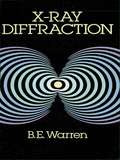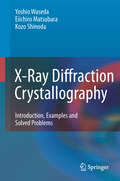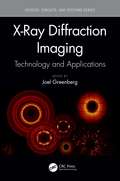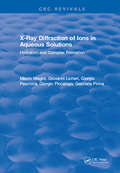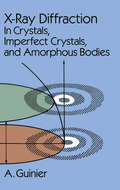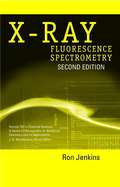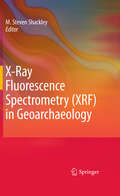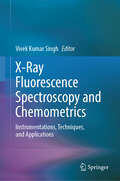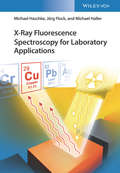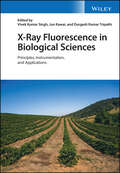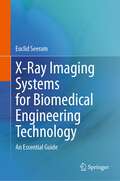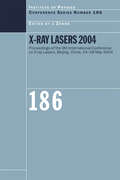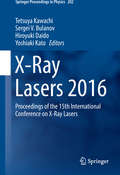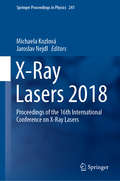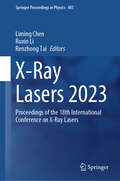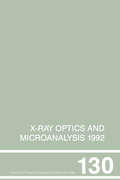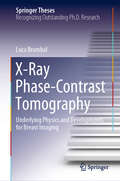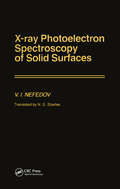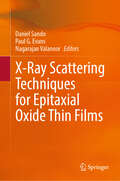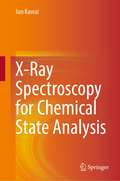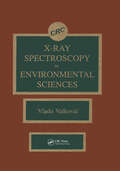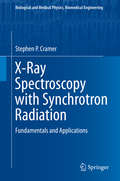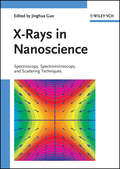- Table View
- List View
X-Ray Diffraction
by B. E. WarrenBasic diffraction theory has numerous important applications in solid-state physics and physical metallurgy, and this graduate-level text is the ideal introduction to the fundamentals of the discipline. Development is rigorous (throughout the book, the treatment is carried far enough to relate to experimentally observable quantities) and stress is placed on modern applications to nonstructural problems such as temperature vibration effects, order-disorder phenomena, crystal imperfections, the structure of amorphous materials, and the diffraction of x-rays in perfect crystals.Carefully selected problems have been included at the end of each chapter to help the student test his grasp of the material.
X-Ray Diffraction Crystallography
by Eiichiro Matsubara Kozo Shinoda Yoshio WasedaX-ray diffraction crystallography for powder samples is a well-established and widely used method. It is applied to materials characterization to reveal the atomic scale structure of various substances in a variety of states. The book deals with fundamental properties of X-rays, geometry analysis of crystals, X-ray scattering and diffraction in polycrystalline samples and its application to the determination of the crystal structure. The reciprocal lattice and integrated diffraction intensity from crystals and symmetry analysis of crystals are explained. To learn the method of X-ray diffraction crystallography well and to be able to cope with the given subject, a certain number of exercises is presented in the book to calculate specific values for typical examples. This is particularly important for beginners in X-ray diffraction crystallography. One aim of this book is to offer guidance to solving the problems of 90 typical substances. For further convenience, 100 supplementary exercises are also provided with solutions. Some essential points with basic equations are summarized in each chapter, together with some relevant physical constants and the atomic scattering factors of the elements.
X-Ray Diffraction Imaging: Technology and Applications (Devices, Circuits, and Systems)
by Joel GreenbergThis book explores novel methods for implementing X-ray diffraction technology as an imaging modality, which have been made possible through recent breakthroughs in detector technology, computational power, and data processing algorithms. The ability to perform fast, spatially-resolved X-ray diffraction throughout the volume of a sample opens up entirely new possibilities in areas such as material analysis, cancer diagnosis, and explosive detection, thus offering the potential to revolutionize the fields of medical, security, and industrial imaging and detection. Featuring chapters written by an international selection of authors from both academia and industry, the book provides a comprehensive discussion of the underlying physics, architectures, and applications of X-ray diffraction imaging that is accessible and relevant to neophytes and experts alike. Teaches novel methods for X-ray diffraction imaging Comprehensive and self-contained discussion of the relevant physics, imaging techniques, system components, and data processing algorithms Features state-of-the-art work of international authors from both academia and industry. Includes practical applications in the medical, industrial, and security sectors
X-Ray Diffraction of Ions in Aqueous Solutions: Hydration And Complex Formation
by Mauro Magini Giovanni Licheri Giorgio Paschina Giorgio Piccaluga Gabriella PinnaFirst Published in 2018. This book is devoted to the description of the basic principles of X-ray diffraction on noncrystalline systems and to the correlation between diffracted intensities and structure. It presents a critical comparison between the results obtained by XRD and the ones obtained by neutron diffraction.
X-Ray Diffraction: In Crystals, Imperfect Crystals, and Amorphous Bodies (Dover Books On Physics Series)
by A. GuinierThis valuable text begins with the general theory of diffraction through the use of Fourier transforms. The author then applies the general results to various atomic structures including amorphous bodies, crystals, and imperfect crystals, whereby the elementary laws of x-ray diffraction from ideal structures follow as a special case. The presentation has been carefully developed to illustrate clearly the meaning of the general equations essential for the study of more complex cases.Readers are assumed to be familiar with the elements of crystallography and x-ray diffraction, and the author has not discussed the problem of determining crystal structures. Rather the focus is on the great variety of imperfect crystals as well as amorphous bodies and liquids. The book should thus be especially useful solid-state physicists, materials scientists, chemists, and biologists with an interest in the scattering from defective structures. More generally, it will benefit all who require a thorough understanding of diffraction theory in order to interpret properly the information provided by modern x-ray diffraction instruments on line profiles, line intensities, diffuse scattering and other phenomena associated with disorder.
X-Ray Fluorescence Spectrometry
by Ron JenkinsX-ray fluorescence spectroscopy, one of the most powerful and flexible techniques available for the analysis and characterization of materials today, has gone through major changes during the past decade.Fully revised and expanded by 30%, X-Ray Fluorescence Spectrometry, Second Edition incorporates the latest industrial and scientific trends in all areas. It updates all previous material and adds new chapters on such topics as the history of X-ray fluorescence spectroscopy, the design of X-ray spectrometers, state-of-the-art applications, and X-ray spectra.Ron Jenkins draws on his extensive experience in training and consulting industry professionals for this clear and concise treatment, covering first the basic aspects of X rays, then the methodology of X-ray fluorescence spectroscopy and available instrumentation. He offers a comparison between wavelength and energy dispersive spectrometers as well as step-by-step guidelines to X-ray spectrometric techniques for qualitative and quantitative analysis-from specimen preparation to real-world industrial application.Favored by the American Chemical Society and the International Centre for Diffraction Data, X-Ray Fluorescence Spectrometry, Second Edition is an ideal introduction for newcomers to the field and an invaluable reference for experienced spectroscopists-in chemical analysis, geology, metallurgy, and materials science.An up-to-date review of X-ray spectroscopic techniques. This proven guidebook for industry professionals is thoroughly updated and expanded to reflect advances in X-ray analysis over the last decade. X-Ray Fluorescence Spectrometry, Second Edition includes:* The history of X-ray fluorescence spectrometry-new to this edition.* A critical review of the most useful X-ray spectrometers.* Techniques and procedures for quantitative and qualitative analysis.* Modern applications and industrial trends.* X-ray spectra-new to this edition.
X-Ray Fluorescence Spectrometry (XRF) in Geoarchaeology
by M. Steven ShackleySince the 1960s, x-ray fluorescence spectrometry (XRF), both wavelength and energy-dispersive have served as the workhorse for non-destructive and destructive analyses of archaeological materials. Recently eclipsed by other instrumentation such as LA-ICP-MS, XRF remains the mainstay of non-destructive chemical analyses in archaeology, particularly for volcanic rocks, and most particularly for obsidian. In a world where heritage and repatriation issues drive archaeological method and theory, XRF remains an important tool for understanding the human past, and will remain so for decades to come. Currently, there is no comprehensive book in XRF applications in archaeology at a time when the applications of portable XRF and desktop XRF instrumentation are exploding particularly in anthropology and archaeology departments worldwide. The contributors to this volume are the experts in the field, and most are at the forefront of the newest applications of XRF to archaeological problems. It covers all relevant aspects of the field for those using the newest XRF technologies to deal with very current issues in archaeology.
X-Ray Fluorescence Spectroscopy and Chemometrics: Instrumentations, Techniques, and Applications
by Vivek Kumar SinghThis book delves into X-ray fluorescence (XRF) spectroscopy, focusing on instrumental developments and data analysis methods employing chemometrics for environmental applications. The integration of information from multiple datasets is gaining an increase in attention and significance in the environmental sciences. In this book, the contributors provide an up-to-date treatment of the most extensively used chemometric methods for predicting and interpreting spectroscopic data in environmental applications. This book describes recent trends in XRF spectroscopic methods, encompassing energy-dispersive and wavelength-dispersive X-ray fluorescence, synchrotron radiation-based XRF, micro-XRF, and total reflection-XRF. It delivers a comprehensive discussion on X-ray detectors and associated imaging applications, along with an exploration of the analytical capabilities of these methods, including detection limits, accuracy, and precision in measurements for environmental samples. Furthermore, this book discusses the numerous advantages and limitations of these techniques, highlighting the latest developments in algorithms based on machine learning, neural networks, and AI for spectroscopic data interpretation. This book caters to researchers across various branches of science and technology, aiming to introduce them to modern techniques coupled with advanced data analysis methods. It serves as a valuable reference for those engaged in XRF spectroscopy techniques, hyphenated XRF spectroscopic techniques, and the characterization of biomolecular systems and environmental samples.
X-Ray Fluorescence Spectroscopy for Laboratory Applications
by Michael Haschke Jörg Flock Michael HallerProvides comprehensive coverage on using X-ray fluorescence for laboratory applications This book focuses on the practical aspects of X-ray fluorescence (XRF) spectroscopy and discusses the requirements for a successful sample analysis, such as sample preparation, measurement techniques and calibration, as well as the quality of the analysis results. X-Ray Fluorescence Spectroscopy for Laboratory Applications begins with a short overview of the physical fundamentals of the generation of X-rays and their interaction with the sample material, followed by a presentation of the different methods of sample preparation in dependence on the quality of the source material and the objective of the measurement. After a short description of the different available equipment types and their respective performance, the book provides in-depth information on the choice of the optimal measurement conditions and the processing of the measurement results. It covers instrument types for XRF; acquisition and evaluation of X-Ray spectra; analytical errors; analysis of homogeneous materials, powders, and liquids; special applications of XRF; process control and automation. An important resource for the analytical chemist, providing concrete guidelines and support for everyday analyses Focuses on daily laboratory work with commercially available devices Offers a unique compilation of knowledge and best practices from equipment manufacturers and users Covers the entire work process: sample preparation, the actual measurement, data processing, assessment of uncertainty, and accuracy of the obtained results X-Ray Fluorescence Spectroscopy for Laboratory Applications appeals to analytical chemists, analytical laboratories, materials scientists, environmental chemists, chemical engineers, biotechnologists, and pharma engineers.
X-Ray Fluorescence in Biological Sciences: Principles, Instrumentation, and Applications
by Vivek Kumar Singh Durgesh Kumar Tripathi Jun KawaiX-Ray Fluorescence in Biological Sciences Discover a comprehensive exploration of X-ray fluorescence in chemical biology and the clinical and plant sciences In X-Ray Fluorescence in Biological Sciences: Principles, Instrumentation, and Applications, a team of accomplished researchers delivers extensive coverage of the application of X-ray fluorescence (XRF) in the biological sciences, including chemical biology, clinical science, and plant science. The book also explores recent advances in XRF imaging techniques in these fields. The authors focus on understanding and investigating the intercellular structures and metals in plant cells, with advanced discussions of recently developed micro-analytical methods, like energy dispersive X-ray fluorescence spectrometry (EDXRF), total reflection X-ray fluorescence spectrometry (TXRF), micro-proton induced X-ray emission (micro-PIXE), electron probe X-ray microanalysis (EPXMA), synchrotron-based X-ray fluorescence microscopy (SXRF, SRIXE, or micro-XRF) and secondary ion mass spectrometry (SIMS). With thorough descriptions of protocols and practical approaches, the book also includes: A thorough introduction to the historical background and fundamentals of X-ray fluorescence, as well as recent developments in X-ray fluorescence analysis Comprehensive explorations of the general properties, production, and detection of X-rays and the preparation of samples for X-ray fluorescence analysis Practical discussions of the quantification of prepared samples observed under X-ray fluorescence and the relation between precision and beam size and sample amount In-depth examinations of wavelength-dispersive X-ray fluorescence and living materials Perfect for students and researchers studying the natural and chemical sciences, medical biology, plant physiology, agriculture, and botany, X-Ray Fluorescence in Biological Sciences: Principles, Instrumentation, and Applications will also earn a place in the libraries of researchers at biotechnology companies.
X-Ray Imaging Systems for Biomedical Engineering Technology: An Essential Guide
by Euclid SeeramThis book addresses X-Ray Imaging Systems intended for biomedical engineering technology students and practitioners, and deals with the major technical components of x-ray imaging modalities. These modalities include film-based imaging, digital radiography, and computed tomography. Furthermore, principles and concepts essential to the understanding of how these modalities function will be described. These include fundamental radiation physics, imaging informatics, quality control, and radiation protection considerations. X-Ray Imaging Systems for Biomedical Engineering Technology: An Essential Guide is intended for biomedical engineering technologists, who provide technical advice and services relating to digital radiography and CT departments not only in hospitals but in private facilities as well. Students in radiological technology programs may also find this to be a useful resource.
X-Ray Lasers 1996: Proceedings of the Fifth International Conference on X-Ray Lasers held in Lund, Sweden, 10-14 June, 1996
by S Svanberg; C-G WahlströmX-Ray Lasers 1996 provides not only an overview and progress report on this fast moving field, but also important reference material on which future work can be built. Topics covered include collisional x-ray lasers, table-top x-ray lasers, beam optics, x-ray optics, OFI and photo-pumped schemes, capillary schemes, international laser facilities, XUV nonlinear mixing, alternative soft x-ray sources, diagnostics, and applications. The volume is an essential addition to the libraries of researchers in the field.
X-Ray Lasers 2004 (Institute of Physics Conference Series)
by Jie ZhangX-Ray Lasers 2004 comprises invited, contributed, and poster papers presented at the 9th International Conference on X-Ray Lasers (ICXRL2004) held in Beijing in May 2004. Some 120 participants from 13 countries and regions met in Beijing to compare results and exchange views on future developments in x-ray lasers and related fields.The book
X-Ray Lasers 2016: Proceedings Of The 15th International Conference On X-ray Lasers (Springer Proceedings In Physics #202)
by Tetsuya Kawachi Sergei V. Bulanov Hiroyuki Daido Yoshiaki KatoDiscusses the latest research topics related to coherent x-ray sources.<P><P> Includes several new proposals for free-electron laser (FEL) using laser- accelerated electrons.<P> Describes the latest methodology and techniques for x-ray coherent diffraction imaging and x-ray interferometry.<P> These proceedings comprise a selection of invited and contributed papers presented at the 15th International Conference on X-Ray Lasers (ICXRL 2016), held at the Nara Kasugano International Forum, Japan, from May 22 to 27, 2016. This conference was part of an ongoing series dedicated to recent developments in the science and technology of x-ray lasers and other coherent x-ray sources with additional focus on supporting technologies, instrumentation and applications. <P> The book showcases recent advances in the generation of intense, coherent x-rays, the development of practical devices and their applications across a wide variety of fields. It also discusses emerging topics such as plasma-based x-ray lasers, 4th generation accelerator-based sources and higher harmonic generations, as well as other x-ray generation schemes.
X-Ray Lasers 2018: Proceedings of the 16th International Conference on X-Ray Lasers (Springer Proceedings in Physics #241)
by Michaela Kozlová Jaroslav NejdlThese proceedings gather a selection of invited and contributed papers presented during the 16th International Conference on X-Ray Lasers (ICXRL 2018), held in Prague, Czech Republic, from 7 to 12 October 2018. The conference is part of an ongoing series dedicated to recent developments in the science and technology of X-ray lasers and other coherent X-ray sources, with an additional focus on supporting technologies, instrumentation and applications. The book highlights advances in a wide range of fields including laser and discharge-pumped plasma X-ray lasers, the injection and seeding of X-ray amplifiers, high-order harmonic generation and ultrafast phenomena, X-ray free electron lasers, novel schemes for (in)coherent XUV, X-ray and γ-ray generation, XUV and X-ray imaging, optics and metrology, X-rays and γ-rays for fundamental science, the practical implementation of X-ray lasers, XFELs and super-intense lasers, and the applications and industrial uses of X-ray lasers.
X-Ray Lasers 2023: Proceedings of the 18th International Conference on X-Ray Lasers (Springer Proceedings in Physics #403)
by Ruxin Li Liming Chen Renzhong TaiThese proceedings present a selection of invited and contributed papers presented during the 18th International Conference on X-Ray Lasers (the 18th ICXRL), held in Shanghai, China, from 17 to 21 July 2023. The conference is part of an ongoing series dedicated to recent developments in the science and technology of X-ray lasers and other coherent X-ray sources, with an additional focus on supporting technologies, instrumentation and applications. The book highlights advances in a wide range of fields including laser and discharge-pumped plasma X-ray lasers, the injection and seeding of X-ray amplifiers, high-order harmonic generation and ultrafast phenomena, X-ray free electron lasers, X-ray and gamma-ray generation, X-ray ghost imaging, optics and metrology, X-rays and γ-rays for fundamental science, the practical implementation of X-ray lasers, XFELs and super-intense lasers, and the applications and industrial uses of X-ray lasers.
X-Ray Optics and Microanalysis 1992, Proceedings of the 13th INT Conference, 31 August-4 September 1992, Manchester, UK
by P.B. Kenway P.J. DukeThe first ICXOM congress held in Cambridge was the brain-child of Dr. Ellis Cosslett, founder of the Electron Optics Section of the Cavendish Laboratory. Dr. Cosslett pioneered research in x-ray optics and microanalysis and retained a close interest in all subject applications for this area of research, including physics, materials science, chemistry, and biology. X-Ray Optics and Microanalysis 1992 was held in his memory. At a special symposium, friends and colleagues reviewed the present status of research in x-ray optics and microanalysis. S.J. Pennycook of Oak Ridge National Laboratory, D.B. Williams of Lehigh University, J.A. Venables et al. of Arizona State University and Sussex University, and C. Jacobsen et al. of SUNY, Stony Brook are among the researchers whose papers are included in this volume.
X-Ray Phase-Contrast Tomography: Underlying Physics and Developments for Breast Imaging (Springer Theses)
by Luca BrombalX-ray imaging is a corner stone of breast cancer diagnosis. By exploiting the phase shift of X-rays rather than their attenuation, phase-contrast tomography has the potential to dramatically increase the visibility of small and low contrast features, thus leading to better diagnosis. This thesis presents research on the first synchrotron-based project developing a clinical phase-contrast breast computed tomography (CT) setup at Elettra, the Italian Syncrotron Radiation Facility. This book includes a comprehensive theoretical background on propagation-based phase-contrast imaging, exploring and extending the most recent image formation models. Along with theory, many practical implementation and optimization issues, ranging from detector-specific processing to setup geometry, are tackled on the basis of a large number of experimental evidences. Most of the modelling results and data analysis have general validity, being a valuable framework for optimization of phase-contrast setups. Results obtained at synchrotron are also compared with "real world" laboratory sources: both a first-of-its-kind comparison with one of the few hospital breast CT systems and a state-of-the-art implementation of monochromatic phase-contrast micro-tomography with a conventional rotating anode source are presented. On a more general level, this work sheds a light on the importance of synchrotron-based clinical programs, which are key to trigger the long-anticipated transition of phase-contrast imaging from synchrotrons to hospitals.
X-Ray Photoelectron Spectroscopy of Solid Surfaces
by V.I. NefedovThis volume outlines the physical and methodical concepts of X-ray photoelectron spectroscopy (XPS) specifically for surface studies using both inner and valence electron levels. It discusses the theory and practice of XPS qualitative and quantitative analysis of solid state surfaces and provides lists of extended experimental and theoretical data necessary for the determination of concentration and thin film thicknesses. In addition it covers the many problems concerning in-depth profiling, ion sputtering rate and damages of the structure of altered layers, as well as applications of angular dependence of the intensities and photoelectron diffraction for surface studies. Also provided are the applications of XPS for the investigations of catalysts, adsorption, electronic surface states, oxydation of semi-conductors and alloys, minerals, including lunar regolith and natural gold, glasses, radiation damage, surface diffusion, polymers, etc.
X-Ray Scattering Techniques for Epitaxial Oxide Thin Films
by Daniel Sando Paul G. Evans Nagarajan ValanoorThis book acts as a handbook on the topic of x-ray scattering as applied to epitaxial complex oxide films, providing detailed information to collect the data, how to analyze the data and the practical sides of the experiments. The first chapter considers laboratory-based X-ray diffraction (XRD) methods: the indispensable X-ray characterization methods used for phase analysis, epitaxial relationship determination, advanced analytical and data fitting techniques, and grazing incidence diffraction. The subsequent chapters focus on advanced techniques that are typically performed at large-scale facilities such as synchrotrons: diffuse scattering and strain mapping, coherent X-ray methods, magnetic X-ray scattering and dichroism effects, and pump-probe techniques. In addition, detailed characterization methods for complex structures such as oxide superlattices, the measurement of oxygen octahedra rotations, and probing of domain arrangements are covered. The overarching aim of the book is to provide a tutorial-style approach to assist experimentalists actually carrying out their experiments and data analysis. (For instance, the nitty gritty techniques of alignment and experimental setup, along with common mistakes and pitfalls, are often not discussed in textbooks or instruction manuals.). The book is an invaluable tool for the wide range of researchers working globally on &‘oxide electronics,&’ serves as a reference text for the many and varied techniques applied to such materials systems, and showcases new advanced methods in x-ray scattering.
X-Ray Spectroscopy for Chemical State Analysis
by Jun KawaiThis book focuses on X-ray spectroscopy for chemical state analysis covering X-ray physics, spectroscopic characteristics used for functional and toxic materials, and the author's ideas related to X-ray experiments. This book also provides novel theoretical interpretations of X-ray spectra along with experimental techniques needed for both synchrotron radiation users and laboratory experimentalists. Presenting not only practical information, this book also covers basic knowledge of commercially available spectrometers and the basic physics of optics and electromagnetism related to X-rays. Furthermore, the author introduces the forgotten history of X-ray physics in the beginning of twentieth century. This book is of use for researchers studying catalysts, charge-transfer materials, surface characterization, and toxic trace elements via X-ray spectroscopy for chemical state analysis as well as quantitative analysis.
X-Ray Spectroscopy in Environmental Sciences
by Vlado ValkovicApplications of X-ray spectroscopy to air, water, and soil pollution studies are covered in detail in this essential publication. Air pollution can hardly be studied by any other method to such an extent. Much of our present knowledge in this field was obtained by laboratories using many of the same methods described in this work. A number of examples illustrate the contribution of X-ray emission spectroscopy and its capabilities in the area of water pollution. Examples of soil pollution studies by the use of biological monitors is also presented. A comprehensive reference list with the help of author and subject indices provides direction for further investigation.
X-Ray Spectroscopy with Synchrotron Radiation: Fundamentals and Applications (Biological and Medical Physics, Biomedical Engineering)
by Stephen P. CramerSynchrotron radiation has been a revolutionary and invaluable research tool for a wide range of scientists, including chemists, biologists, physicists, materials scientists, geophysicists. It has also found multidisciplinary applications with problems ranging from archeology through cultural heritage to paleontology. The subject of this book is x-ray spectroscopy using synchrotron radiation, and the target audience is both current and potential users of synchrotron facilities. The first half of the book introduces readers to the fundamentals of storage ring operations, the qualities of the synchrotron radiation produced, the x-ray optics required to transport this radiation, and the detectors used for measurements. The second half of the book describes the important spectroscopic techniques that use synchrotron x-rays, including chapters on x-ray absorption, x-ray fluorescence, resonant and non-resonant inelastic x-ray scattering, nuclear spectroscopies, and x-ray photoemission. A final chapter surveys the exciting developments of free electron laser sources, which promise a second revolution in x-ray science. Thanks to the detailed descriptions in the book, prospective users will be able to quickly begin working with these techniques. Experienced users will find useful summaries, key equations, and exhaustive references to key papers in the field, as well as outlines of the historical developments in the field. Along with plentiful illustrations, this work includes access to supplemental Mathematica notebooks, which can be used for some of the more complex calculations and as a teaching aid. This book should appeal to graduate students, postdoctoral researchers, and senior scientists alike.
X-Rays and Extreme Ultraviolet Radiation
by Linda David Attwood Sakdinawat Anne Geniesse Anne Sakdinawat Linda GeniesseThis detailed, comprehensive book describes the fundamental properties of soft X-rays and extreme ultraviolet (EUV) radiation and discusses their applications in a wide variety of fields, including EUV lithography for semiconductor chip manufacture and soft X-ray biomicroscopy. The author begins by presenting the relevant basic principles such as radiation and scattering, wave propagation, diffraction, and coherence. He then goes on to examine a broad range of phenomena and applications. The topics covered include spectromicroscopy, EUV astronomy, synchrotron radiation, and soft X-ray lasers. The author also provides a wealth of useful reference material such as electron binding energies, characteristic emission lines and photo-absorption cross-sections. The book will be of great interest to graduate students and researchers in engineering, physics, chemistry, and the life sciences. It will also appeal to practising engineers involved in semiconductor fabrication and materials science.
X-Rays in Nanoscience: Spectroscopy, Spectromicroscopy, and Scattering Techniques
by Jinghua GuoAn up-to-date overview of the different x-ray based methods in the hot fields of nanoscience and nanotechnology, including methods for imaging nanomaterials, as well as for probing the electronic structure of nanostructured materials in order to investigate their different properties. Written by authors at one of the world's top facilities working with these methods, this monograph presents and discusses techniques and applications in the fields of x-ray scattering, spectroscopy and microscope imaging. The resulting systematic collection of these advanced tools will benefit graduate students, postdocs as well as professional researchers.
